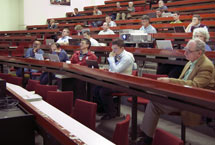
Handy Links
SLAC News Center
SLAC Today
- Subscribe
- Archives: Feb 2006-May 20, 2011
- Archives: May 23, 2011 and later
- Submit Feedback or Story Ideas
- About SLAC Today
SLAC News
Lab News
- Interactions
- Lightsources.org
- ILC NewsLine
- Int'l Science Grid This Week
- Fermilab Today
- Berkeley Lab News
- @brookhaven TODAY
- DOE Pulse
- CERN Courier
- DESY inForm
- US / LHC
SLAC Links
- Emergency
- Safety
- Policy Repository
- Site Entry Form

- Site Maps
- M & O Review
- Computing Status & Calendar
- SLAC Colloquium
- SLACspeak
- SLACspace
- SLAC Logo
- Café Menu
- Flea Market
- Web E-mail
- Marguerite Shuttle
- Discount Commuter Passes
-
Award Reporting Form
- SPIRES
- SciDoc
- Activity Groups
- Library
Stanford
Around the Bay
Collaboration Meeting Explores BaBar Strategy from Data Preservation to Dark Higgs Search
The BaBar collaboration wrapped up last Thursday after over 150 team members converged at SLAC to discuss ongoing physics analysis, plan for long term data access during their archival period and celebrate a record 400 published papers.
"Such high attendance is proof that physicists remain strongly committed to the collaboration," said spokesman Francois Le Diberder, "Meetings were fueled with passion to discuss physics issues in depth."
Le Diberder considers the meeting a great success, which signals very good health for the BaBar Collaboration.
The meeting's parallel and plenary sessions were mainly devoted to presenting data analysis conducted in the last months. The data collection phase of BaBar ended in 2008 and the collaboration is now focused on the analysis of this very rich data set. Most interestingly, theoreticians have proposed that evidence of dark matter may currently be lurking in BaBar's data.
"Data anomalies are either errors in errors in the analyses or sign for new physics," said SLAC physicist Hojeong Kim. It is possible that dark matter events have already occurred during BaBar's run and are waiting to be discovered.
The collaboration has set up a dark matter task force to search for dark matter and other exotic particles, following theoretical work that established that dark matter could have been produced during BaBar's run. Researchers are investigating particular particular types of collision products, reassessing the full data set to seek dark photons and mesons, and even looking at data for a dark Higgs boson.
Another important task at the meeting was the discussion of future data preservation and long term analysis of this data. On Monday, BaBar Computing Coordinator Homer Neal gave a talk about creating an archival system to meet the needs of analysts working with the BaBar data in the future.
Before the archival system can be set up, it needs rigorous testing to ensure it adequately provides all the functions needed to carry an analysis from its inception to its publication. "We plan to soon have a prototype archival system that we will ask analysts to test and identify what is missing or needs improving" says Neal. In December, the followup to the 2nd Data Preservation and Long Term Analysis Workshop, which was held at SLAC in May of this year, will be held at CERN and will address data preservation in high energy physics at the global scale.
The meeting did not just encompass work. Bill Wisniewski, who recently was promoted from being BaBar's Technical Coordinator to being the Deputy Director of PPA, was honored for his exceptional service at BaBar's social event Wednesday night with gifts of fine wines from each country involved in BaBar. Wisniewski has been with the collaboration since its inception, and a key member of the BaBar management team since 2000.
The collaboration also awarded the winners of the internal Champagne Challenge with—what else—a bottle of champagne. The prize went to Swagato Banerjee, Clayton Lindsay, Christopher Locke, Michael Roney, Alberto Cervelli, Giovanni Marchiori, and Marcello Giorgi for submitting the first BaBar paper using the latest reprocessing of the data from all seven of BaBar's run cycles.
—Adam Mann
SLAC Today, November 9, 2009
